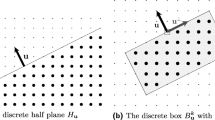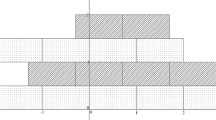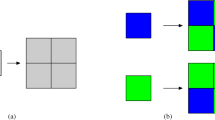Abstract
In the famous works “Tilings, substitution systems and dynamical systems generated by them” by S. Mozes and “Matching rules and substitution tilings” by Ch. Goodman-Strauss, important properties of tiling on the plane connecting the language of substitution systems and local rules are investigated. In particular, it is proved that with almost any substitution system of tiles, it is possible to link a system of decorations and local rules to the boundaries of tiles in such a way that any tiling of the plane allowed by the rules will belong to the family generated by this substitution system.
Geometric constructions based on tiling and geometric complexes of glued squares open up new opportunities for the study and construction of algebraic objects. An important property of tiling that allows them to be associated with algebraic objects is determinicity. For square tiles whose sides are painted in a finite number of colors, this property means that the colors of the two adjacent sides of each tile uniquely determine the colors of the other pair of sides. J. Kari and P. Papasoglu constructed a deterministic aperiodic set. Thus, the analogue of the theorems of Goodman-Strauss and Mozes with an additional determinicity condition is an important statement in the theory of aperiodic mosaics. We prove an analog of this statement for a specific fixed substitution system. But its arbitrariness allows us to hope for the possibility of improving the construction for the general case.
This system is important when constructing an infinite finitely presented nilsemigroup, which solves the problem of L. N. Shevrin and M. V. Sapir. The work is also devoted to the construction of a family of geometric complexes and the introduction of coding of vertices and edges on them. For the resulting complex, both properties are fulfilled simultaneously: finiteness of the set of defining local rules and determinicity on paths of length 2 on minimal squares.
Similar content being viewed by others
References
R. Berger, The Undecidability of the Domino Problem, Ph.D. Thesis, Harvard University (1964).
J. Conway and J. Lagarias, “Tiling with polyminoes and combinatorial group theory,” J. Combin. Theory, Ser. A, 53, No. 2, 183–208 (1990).
B. Durand, L. Levin, and A. Shen, “Local rules and global order, or aperiodic tilings,” Math. Intelligencer, 27, 64–68 (2005).
Ch. Goodman-Strauss, “Matching rules and substitution tilings,” Ann. Math. (2), 147, No. 1, 181–223 (1998).
M. Gromov, “Hyperbolic Groups,” in: Essays in Group Theory, S. M. Gersten, ed., MSRI Publ., Vol. 8, Springer (1987), pp. 75–263.
I. A. Ivanov-Pogodaev and A. Ya. Kanel-Belov, “Finitely presented nilsemigroups: complexes with the property of uniform ellipticity,” Izv. Math., 85, No. 6, 1146–1180 (2021).
I. Ivanov-Pogodaev, S. Malev, and O. Sapir, “A construction of a finitely presented semigroup containing an infinite squarefree ideal with zero multiplication,” Int. J. Algebra Comput., 28, No. 8, 1565–1573 (2018).
J. Kari and P. Papasoglu, “Deterministic aperiodic tile sets,” Geom. Funct. Anal., 9, 353–369 (1999).
Sh. Mozes, “Tilings, substitution systems, and dynamical systems generated by them,” J. Anal. Math., 53, No. 1, 139–186 (1989).
R. M. Robinson, “Undecidability and nonperiodicity for tilings of the plane,” Invent. Math., 12, 177–209 (1971).
Wang Hao, “Proving theorems by pattern recognition. II,” Bell System Tech. J., 40, No. 1, 1–41 (1961).
D. Wise, Non-Positively Curved Squared Complexes, Aperiodic Tilings, and Non-Residually Finite Groups, Ph.D. Thesis, Princeton University (1996).
D. Wise, “Cubulating small cancellation groups,” Geom. Funct. Anal., 14, 150–214 (2004).
Author information
Authors and Affiliations
Corresponding author
Additional information
Translated from Fundamentalnaya i Prikladnaya Matematika, Vol. 24, No. 2, pp. 37–180, 2022.
Rights and permissions
Springer Nature or its licensor (e.g. a society or other partner) holds exclusive rights to this article under a publishing agreement with the author(s) or other rightsholder(s); author self-archiving of the accepted manuscript version of this article is solely governed by the terms of such publishing agreement and applicable law.
About this article
Cite this article
Ivanov-Pogodaev, I.A., Kanel-Belov, A.Y. Deterministic Coloring of a Family of Complexes. J Math Sci 275, 403–501 (2023). https://doi.org/10.1007/s10958-023-06691-9
Published:
Issue Date:
DOI: https://doi.org/10.1007/s10958-023-06691-9




